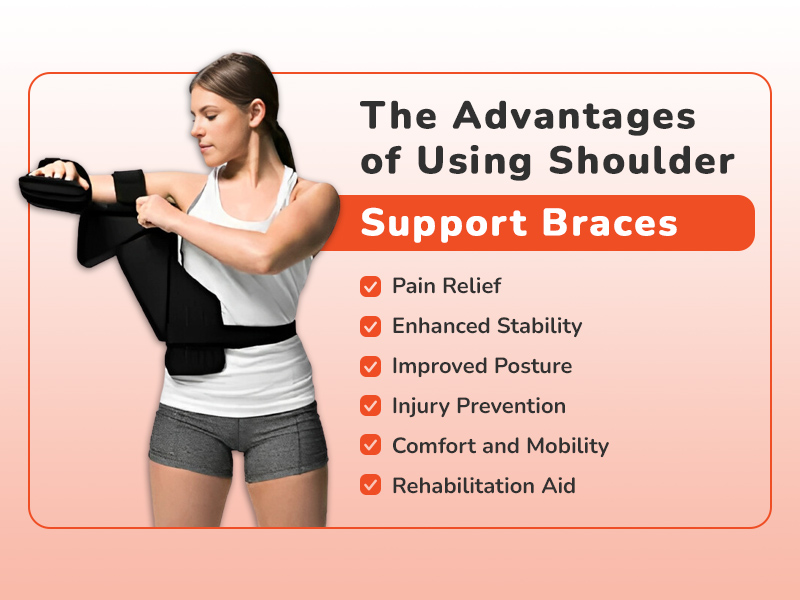Shoulder Stability: Finding Daily Comfort with Shoulder Support Braces
In our daily lives, shoulder stability is a cornerstone that often goes unnoticed until discomfort or instability creeps in. From reaching for a cup of coffee to engaging in sports or carrying groceries, our shoulders are indispensable. However, when shoulder discomfort or instability arises, it can cast a shadow over our daily routines. In this article, we’ll delve into shoulder support braces, illuminating their simple yet highly effective role in enhancing shoulder stability, reducing pain, and providing the daily comfort we all seek. These unassuming devices hold the potential to restore the harmony of our shoulders, allowing us to perform tasks with ease and embrace life’s activities confidently.
Understanding Shoulder Stability
Understanding the critical role of shoulder stability in our daily lives and recognizing the potential causes of instability and pain are the first steps in maintaining and improving shoulder health. Shoulder stability is a vital component of our daily lives, impacting our ability to perform various activities easily and confidently. In this section, we’ll explore the essential role that shoulder stability plays in our day-to-day existence and delve into common causes of shoulder instability and pain.
The Role of Shoulder Stability in Daily Life
- Everyday Tasks: Shoulder stability is crucial for everyday tasks such as reaching for objects on high shelves, lifting groceries, or combing your hair. It enables us to perform these activities smoothly and without discomfort.
- Sports and Physical Activities: Whether you enjoy playing sports, gardening, or engaging in recreational activities, your shoulders play a pivotal role in these pursuits. Shoulder stability is essential for optimal performance and injury prevention during physical activities.
- Posture and Comfort: Good posture is closely linked to shoulder stability. When your shoulders are stable, you can maintain an upright and comfortable posture, reducing the risk of discomfort or pain.
Common Causes of Shoulder Instability and Pain
- Trauma and Injury: Accidents, falls, or direct impacts to the shoulder can result in injuries such as dislocations, fractures, or soft tissue damage. These injuries can lead to shoulder instability and pain.
- Overuse and Repetitive Strain: Repeatedly engaging in overhead motions or activities that strain the shoulder, such as swimming or throwing, can cause overuse injuries. These injuries may result in instability and discomfort.
- Muscle Imbalances: Weakness or imbalances in the muscles surrounding the shoulder joint can lead to instability. It’s essential to maintain a balanced and well-conditioned shoulder musculature.
- Age-Related Changes: As we age, the structures within our shoulder joint can undergo degenerative changes. Conditions like osteoarthritis and rotator cuff tears become more common, contributing to shoulder instability and pain.
The Benefits of Shoulder Support Braces
Shoulder support braces are versatile tools that offer a multitude of advantages. Whether you seek pain relief, enhanced stability, improved posture, or injury prevention, these braces can restore comfort and confidence in your daily life. Understanding how they work and choosing the right one for your needs can lead to a healthier and more comfortable shoulder experience.
How Shoulder Support Braces Work
Shoulder support braces are designed to provide stability and support to the shoulder joint. They typically consist of adjustable straps, padding, and sometimes rigid elements to achieve their purpose. Here’s how they work:
- Stabilization: The primary function of a shoulder support brace is to stabilize the shoulder joint. By limiting excessive movement and providing external support, these braces help prevent further injury and discomfort.
- Compression: Many shoulder support braces offer compression, which can reduce inflammation and promote healing. This compression is particularly beneficial for individuals recovering from shoulder injuries or surgeries.
- Posture Correction: Some shoulder braces encourage proper shoulder and upper back posture. They gently pull the shoulders back and align them more naturally, reducing the tendency to slouch or hunch.
The Advantages of Using Shoulder Support Braces

- Pain Relief: Shoulder support braces can significantly alleviate shoulder pain, whether caused by an injury, overuse, or a medical condition like arthritis. The compression and support they provide can ease discomfort and promote healing.
- Enhanced Stability: These braces offer enhanced stability, making them particularly valuable for individuals with shoulder instability or those recovering from surgery. They reduce the risk of further injuries during physical activities.
- Improved Posture: Certain shoulder support braces double as posture correctors. By gently coaxing the shoulders into a proper alignment, they can help improve posture and reduce the risk of discomfort associated with poor posture.
- Injury Prevention: Even if you don’t have shoulder issues, wearing a support brace during physically demanding activities or sports can be a preventive measure. It reduces the risk of overuse injuries and strain.
- Comfort and Mobility: Shoulder support braces are designed with comfort in mind. They are adjustable to fit different body sizes and can be worn discreetly under clothing, allowing for a wide range of motion without hindrance.
- Rehabilitation Aid: For those during shoulder rehabilitation, these braces can provide the necessary support to promote healing and prevent further injury during the recovery process.
Choosing the Right Shoulder Support Brace
The appropriate shoulder support brace is crucial for achieving the desired benefits and comfort. This section will explore the various types of shoulder support braces available and provide essential considerations to help you choose the most suitable brace for your unique needs.
Types of Shoulder Support Braces Available
- Shoulder Immobilizers: These braces are designed to restrict shoulder movement entirely. They are often used post-surgery or for severe shoulder injuries that require complete immobilization.
- Shoulder Slings: Slings are worn to support the arm and shoulder during the initial stages of recovery after an injury or surgery. They cradle the arm, providing support while allowing some mobility.
- Shoulder Stabilizers: Stabilizers are versatile braces that offer support and compression to the shoulder joint. They suit various conditions, including instability, rotator cuff injuries, and general shoulder discomfort.
- Posture Corrector Braces: Some shoulder support braces double as posture correctors. They are designed to gently pull the shoulders back into a proper alignment, helping to improve posture over time.
- Compression Sleeves: These sleeves compress the shoulder and upper arm area. They are ideal for individuals seeking pain relief and improved circulation without the bulk of a traditional brace.
Considerations for Selecting the Most Suitable Brace
- Consult a Healthcare Professional: Before choosing a shoulder support brace, it’s advisable to consult with a healthcare provider or orthopedic specialist. They can assess your condition and provide personalized recommendations.
- Identify Your Condition: Determine the specific issue or condition you are addressing. Is it post-surgery recovery, instability, pain relief, or posture improvement? Different braces are designed for different purposes.
- Size and Fit: Ensure that the brace fits you correctly. Most braces are adjustable, but following sizing guidelines is essential to ensure a snug and comfortable fit.
- Comfort and Breathability: Consider the material and design of the brace. It should be comfortable to wear for extended periods and allow for proper ventilation to prevent sweating and skin irritation.
- Ease of Use: Some braces are easier to wear and take off than others. Depending on your mobility and dexterity, you may prefer a brace with adjustable straps or a simple slip-on design.
- Activity Level: Think about your level of physical activity. If you lead an active lifestyle, you’ll want a brace that provides support without hindering your range of motion.
- Budget: Prices for shoulder support braces can vary. Determine your budget and look for options that meet your needs while staying within your financial constraints.
Daily Comfort Solutions
Incorporating shoulder support into your daily routine can significantly improve comfort, mobility, and overall well-being. This section will explore practical ways to seamlessly integrate shoulder support into your life and highlight the transformative impact it can have on your everyday activities and comfort.
Read More: Maximizing Comfort and Support: The Essential Guide to Wrist Braces
Incorporating Shoulder Support into Your Routine

- Morning Routine: Start your day by putting on your shoulder support brace. Whether dealing with a specific shoulder condition or seeking a better posture, wearing the brace during your morning routine sets a positive tone for the day.
- Work or Desk Activities: If your daily activities involve long hours at a desk or computer, wearing a shoulder support brace can help maintain proper posture. It reminds you to sit up straight, reducing strain on your shoulders and upper back.
- Physical Activities: If you’re engaging in physical activities or sports, choose a shoulder support brace for active use. These braces provide stability and reduce the risk of injury during exercise or sports practice.
- Household Chores: Whether gardening, cleaning, or cooking, shoulder support can make these tasks more comfortable. The brace provides stability and support, reducing the strain on your shoulders as you do your chores.
- Recreational Activities: Enjoying hobbies or recreational activities like golf, tennis, or hiking is more pleasurable with the added support of a shoulder brace. It allows you to pursue your passions with less discomfort.
The Impact on Everyday Activities and Comfort
- Pain Reduction: Shoulder support braces can significantly reduce shoulder pain and discomfort. Whether you have a specific shoulder condition or need better posture, the brace’s support can alleviate strain and pain.
- Improved Posture: One of the key benefits of shoulder support is posture improvement. Over time, the brace helps train your shoulders to stay more natural and upright, reducing the tendency to slouch or hunch.
- Enhanced Confidence: With reduced pain and improved posture, you’ll likely experience a boost in confidence. Standing tall and carrying yourself gracefully can enhance your self-assuredness in various social and professional settings.
- Increased Mobility: Shoulder support allows for better mobility and range of motion. You can move more freely and engage in activities without fearing aggravating your shoulder condition.
- Long-Term Benefits: Consistently incorporating shoulder support into your daily routine can lead to long-term benefits. It can help prevent future shoulder issues, maintain comfort, and promote overall shoulder health.
Conclusion
In the quest for daily comfort and stability, shoulder support braces emerge as invaluable allies. Through our exploration of shoulder stability, the benefits of shoulder support braces, and the considerations for choosing the right one, we’ve uncovered a path to improved shoulder health and enhanced daily comfort. As you bid farewell to discomfort and instability, you open the door to a life where shoulder braces provide the support needed for a more comfortable and active existence. Say goodbye to limitations and welcome the freedom to move confidently and easily. With shoulder support braces by your side, your daily journey becomes a symphony of comfort, ensuring that every moment is met with the assurance of shoulder stability.



